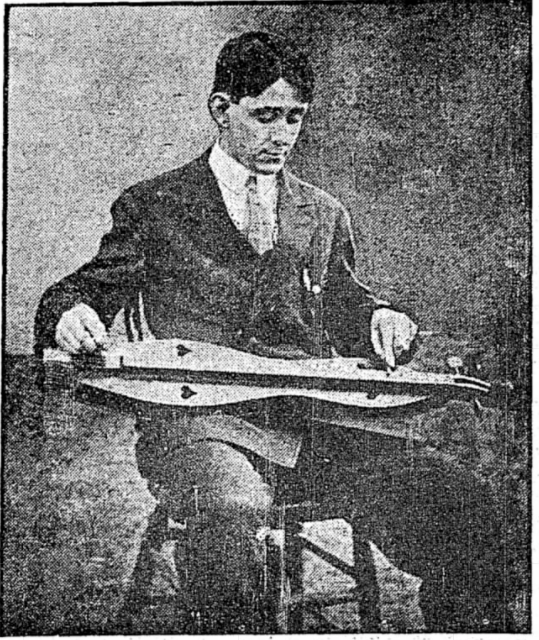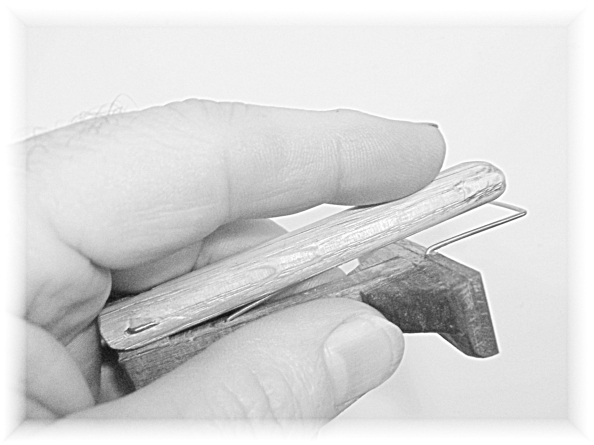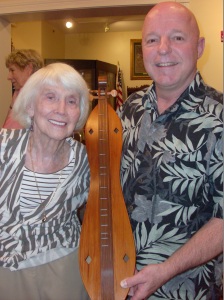We don’t know why J. Edward Thomas used the design he did. It could possibly be his twist on another instrument he studied at a younger age. We know it changed very little over the years; I suppose if it aint broke don’t fix it. His work was only inconsistent in about a pencil width for the most part. It has been said he was always carving on something he could readily pull from his pocket and was an incredible carver. Peg heads are the dulcimore makers play ground and one example is the dog head peg head he carved for Josiah Combs graduation gift.
The peg head has been a maker’s mark for several makers. Homer started changing his peg head early on. He tapered the end and in doing so created the design that he would be known for. Thomas didn’t need to change anything, when you are first in the field your work is all original. His peg head was small and simple, and he could probably carve one out in minutes with little or no lay out! Others tried various scrolls not unlike a violin peg head, or simplified versions of the scroll.
The sound holes have been another maker’s mark for some. Early on the inverted heart shape was almost tradition; this and of course the round hole that was no more than a simple drilled hole. As for makers’ identification, Doug Birch has used this wonderful reversed comet streak, and only on one side! You can identify one of his instruments from across the room. David McKinney has this design with six holes circling a center hole. Again a design that is very simple but very distinctively original and recognizable. Homer Ledford used the diamond shape in his early years. I believe the fact that so many makers will “give you what you want” has limited the originality of the sound holes design.
There are only so many changes that you can make to a sound box, few that mark the maker other than the nontraditional shapes. Peg heads have given way to machine heads on the contemporary dulcimer; I have not studied the modern pieces enough to comment on that so I will stay with peg heads. Homer Ledford tapered the sides of the simplistic scroll and it was a decision that marked his design indefinitely. Many spend hours carving wonderful violin scrolls, but there is very little to differentiate one from another. The makers can tell the difference from one an others work, but I believe the public just see a wonderful carving. I wrestled with the peg head design for quite some time and I Googled images of them for weeks. What I came up with to differentiate mine was the carved ball. It holds a leather lanyard very well for hanging and eliminates wrapping the lanyard around the pegs. Others had tapered the scroll beyond the side but none had rounded the peg head. Now I had a simple original design that was easily recognizable from across the room!
After a few dozen peg heads, I decided to make a really finely finished one. Most peg head have some sort of tooling marks on them and most have rough tool marks inside the peg hollows bottom. I sat in the chair and carved, sanded, filed, wet out the surface and let it dry and did it all over again. I had a finely finished peg head! Once I oiled and waxed it, it was beautiful! Funny thing though, it wasn’t right. Dulcimore aint’ fine, dulcimore aint’ shiny, dulcimore aint’ finely finished.
So it begins. I have to find out for myself, what to leave in and what to leave out. There was going to be tooling marks left in each piece. Something to differentiate each piece from others manufactured ones. First the tools used to make the dulcimore will determine the markings. Technology has always been a factor with craftsman. For millennium makers have struggled with new tool inventions. No different from new fasteners like carpenters glue. We still struggle over carpenters or hide glue; each one has benefits and problems in use. The more I look and use the old tools, the more I like them. I refer to the new technology as separating us from the wood. Machines are loud and very quick. In manufacturing, less time is more money and less experience is needed to operate the tools. You must know the wood to properly hand finish a panel. A piece of wood ran through a thickness sander, not so much. Run out of the grain determines the planing process, so the wood tells you how it is to be finished.
The hand tools themselves have changed very little. Rip and crosscut saws kept sharp are quick and relatively effortless. Chisels, knives and plane irons are sharpened a little more than yesteryear. Paul Sellers, a wood working author, did a piece about sharpening up to; 250 grit. I can imagine the old masters having a Norton India stone, or one very similar to it to finish off each tool as needed. We use whet stones up to 5000 or more, then strop with paste to polish the edge! “Overkill?” Yes, sharpening has taken on a specialty craft in its self, but you really don’t need to go that far. Cabinet scrapers have fallen out of favor to sand paper. We know Thomas used sand paper so I see nothing wrong with it. “To each craftsman his own.”
I talk of separation from the wood. The machines don’t have to think about what they are doing. They are in fact indifferent to the wood. They also take away what is wood! What I mean by this is; you lose what the wood is aesthetically. Wood has grain. It’s not just esthetics; there is a texture to it too. First the surface is made flat, and then the lacquer seals it with a plastic like coating on contemporary pieces. It can be satin or flat finish but to me doesn’t seem to look “warm”. The shellac and wax, or hand rubbed oil doesn’t remove the texture, but enhances it. These finishes are also not as slick as the lacquers. So a few tool marks left enhances the piece aesthetically, and the “warm” traditional finish is perfection with its imperfections!
 I’ve only been at this “Traditional Appalachian Dulcimore” for a few years. I’m going to guess my insights are different as the result of my being a dulcimore maker. In my first recollection of early pieces there were references to the “play-ability” of many pieces. Some referred to the unplayable pieces as “wall hangers” and the makers were subject to unfavorable review. What I find problematic with the review is; was the piece original, or had it in fact been “repaired”? Early on I found pieces that the intonation was set a particular way. The early pieces were generally Ionian, tuned a full note lower and played with a noter. The contemporary players tuned them Mixolydian a full note higher and lowered the action, then complained it “wasn’t right”. If you don’t know how a particular maker set his intonation, you can’t fully appreciate the piece.
I’ve only been at this “Traditional Appalachian Dulcimore” for a few years. I’m going to guess my insights are different as the result of my being a dulcimore maker. In my first recollection of early pieces there were references to the “play-ability” of many pieces. Some referred to the unplayable pieces as “wall hangers” and the makers were subject to unfavorable review. What I find problematic with the review is; was the piece original, or had it in fact been “repaired”? Early on I found pieces that the intonation was set a particular way. The early pieces were generally Ionian, tuned a full note lower and played with a noter. The contemporary players tuned them Mixolydian a full note higher and lowered the action, then complained it “wasn’t right”. If you don’t know how a particular maker set his intonation, you can’t fully appreciate the piece.


